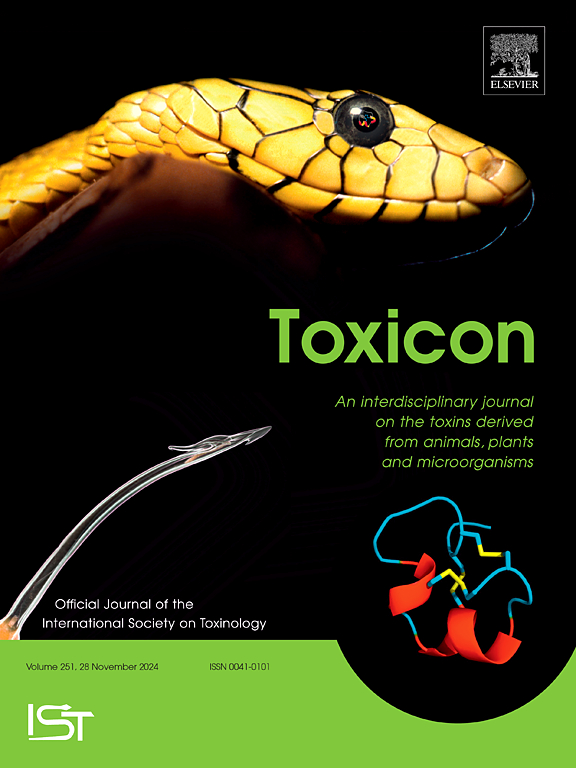咀嚼烟草或无烟烟草中产生黄曲霉毒素的曲霉的分子和荧光检测和分离方法
IF 2.6
4区 医学
Q2 PHARMACOLOGY & PHARMACY
引用次数: 0
摘要
烟草含有许多有害的化学物质、毒素和致癌物,会对健康造成严重危害。真菌毒素存在于所有形式的烟草中,包括对人体健康有害并与不同类型的癌症有关的无烟烟草。利用微生物学和分子技术鉴定了SLT中产黄曲霉的种类。在卡拉奇的不同地点随机收集了50份咀嚼烟草样本。采用涂布平板法在Sabouraud Dextrose琼脂(SDA)上培养真菌,通过宏观、微观和ITS区扩增对黄曲霉进行鉴定。采用氨蒸汽法和紫外法在椰子琼脂培养基(CAM)上对证实的黄曲霉菌株产黄曲霉毒素进行了分析。同时扩增出黄曲霉毒素相关调控基因aflR和aflS。从SLT样品中鉴定出不同种类的真菌,其中黄曲霉属真菌最占优势。氨气法测定菌株产生黄曲霉毒素的比例为64%,在椰子琼脂培养基(CAM)上产生黄曲霉毒素的比例为43%。黄曲霉毒素仅在黄曲霉阳性样品中测定,含量在10 ~ 47 μg/kg范围内。大部分样品中检测到的黄曲霉毒素浓度均高于FDA推荐标准。本文章由计算机程序翻译,如有差异,请以英文原文为准。

Molecular and fluorometric based approach for the detection and isolation of aflatoxin producing Aspergillus sp. in chewing or smokeless tobacco
Tobacco contains many harmful chemicals, toxins, and carcinogens that can cause serious health hazards. Mycotoxins are present in all forms of tobacco, including smokeless tobacco (SLT) which are harmful for human health and associated with different types of cancer. Using microbial and molecular techniques, we identified aflatoxigenic Aspergillus species in SLT. Fifty samples of chewing tobacco were collected randomly from different locations of Karachi. Fungi were grown on Sabouraud Dextrose agar (SDA) by spread plate method and A. flavus was identified macroscopically, microscopically and by amplifying the ITS region. Confirmed isolates of A. flavus were analyzed for aflatoxin production by Ammonia vapor test and by UV on coconut agar medium (CAM). The regulatory genes (aflR and aflS) associated with aflatoxins in A. flavus were also amplified. Different fungal species were identified from SLT samples in which A. flavus was the most dominant. Aflatoxin production analysis by ammonia vapor test revealed that 64 % isolates were aflatoxigenic while on Coconut agar medium (CAM) 43 % isolates were aflatoxigenic. Aflatoxins were quantified in only A. flavus positive samples which were in the range of 10–47 μg/kg. Aflatoxin concentration detected in SLT was above the recommended level of FDA standard in majority of the samples.
求助全文
通过发布文献求助,成功后即可免费获取论文全文。
去求助
来源期刊

Toxicon
医学-毒理学
CiteScore
4.80
自引率
10.70%
发文量
358
审稿时长
68 days
期刊介绍:
Toxicon has an open access mirror Toxicon: X, sharing the same aims and scope, editorial team, submission system and rigorous peer review. An introductory offer Toxicon: X - full waiver of the Open Access fee.
Toxicon''s "aims and scope" are to publish:
-articles containing the results of original research on problems related to toxins derived from animals, plants and microorganisms
-papers on novel findings related to the chemical, pharmacological, toxicological, and immunological properties of natural toxins
-molecular biological studies of toxins and other genes from poisonous and venomous organisms that advance understanding of the role or function of toxins
-clinical observations on poisoning and envenoming where a new therapeutic principle has been proposed or a decidedly superior clinical result has been obtained.
-material on the use of toxins as tools in studying biological processes and material on subjects related to venom and antivenom problems.
-articles on the translational application of toxins, for example as drugs and insecticides
-epidemiological studies on envenoming or poisoning, so long as they highlight a previously unrecognised medical problem or provide insight into the prevention or medical treatment of envenoming or poisoning. Retrospective surveys of hospital records, especially those lacking species identification, will not be considered for publication. Properly designed prospective community-based surveys are strongly encouraged.
-articles describing well-known activities of venoms, such as antibacterial, anticancer, and analgesic activities of arachnid venoms, without any attempt to define the mechanism of action or purify the active component, will not be considered for publication in Toxicon.
-review articles on problems related to toxinology.
To encourage the exchange of ideas, sections of the journal may be devoted to Short Communications, Letters to the Editor and activities of the affiliated societies.
 求助内容:
求助内容: 应助结果提醒方式:
应助结果提醒方式:


